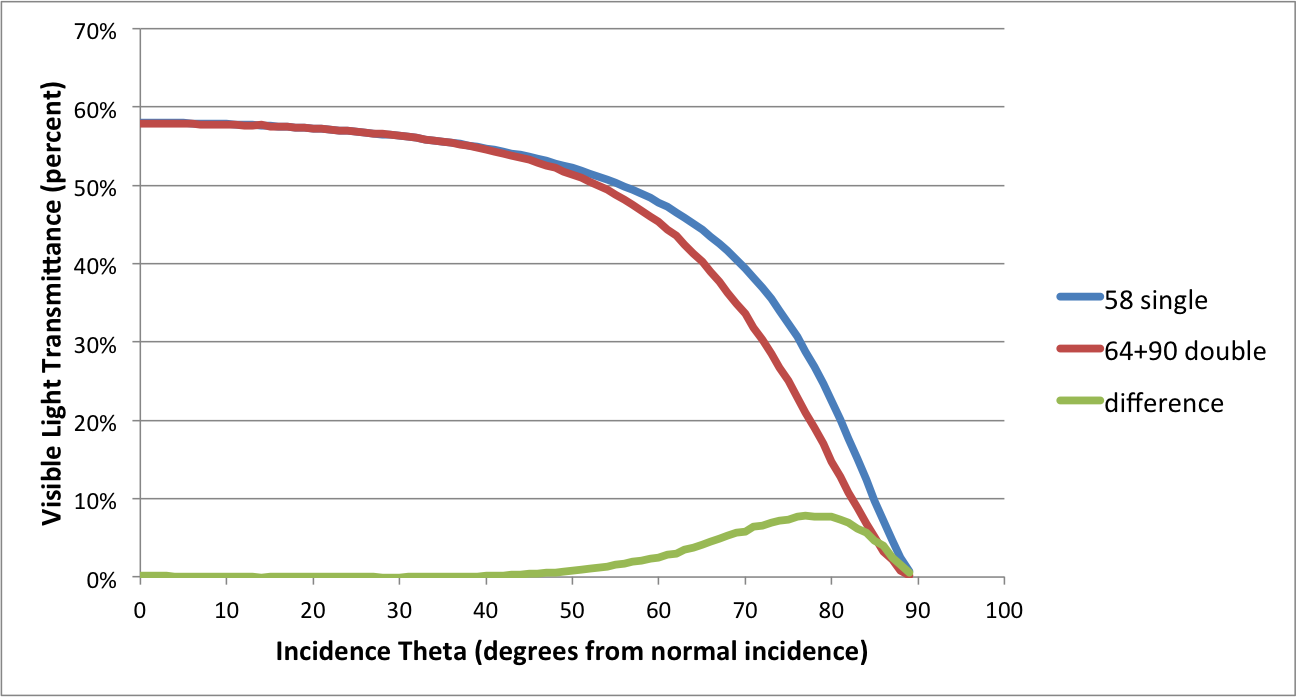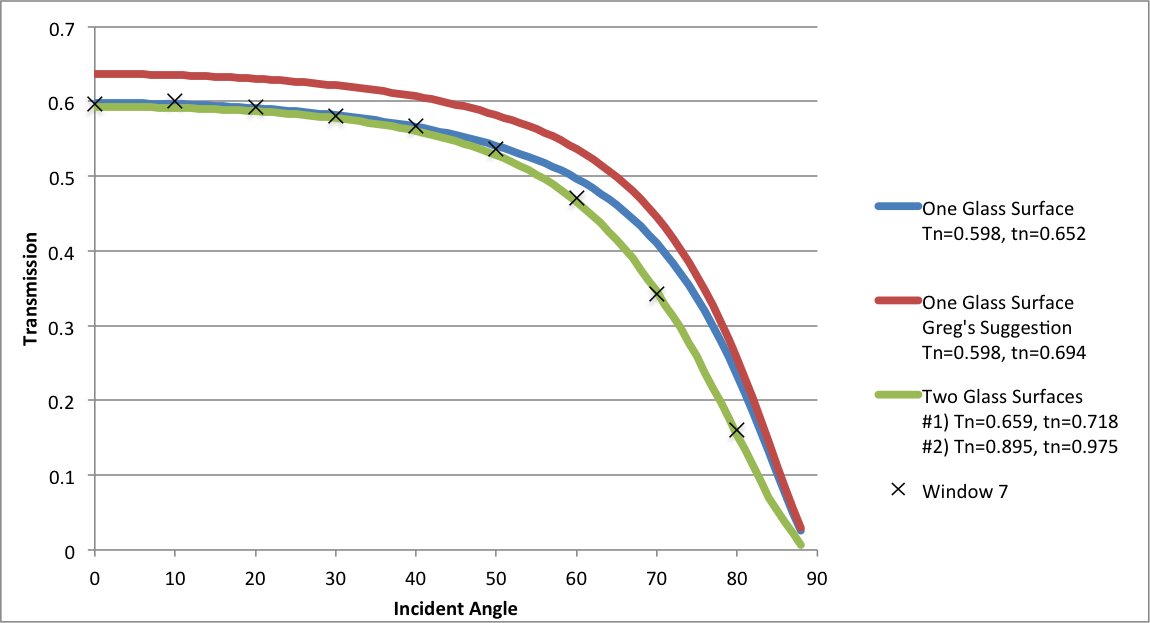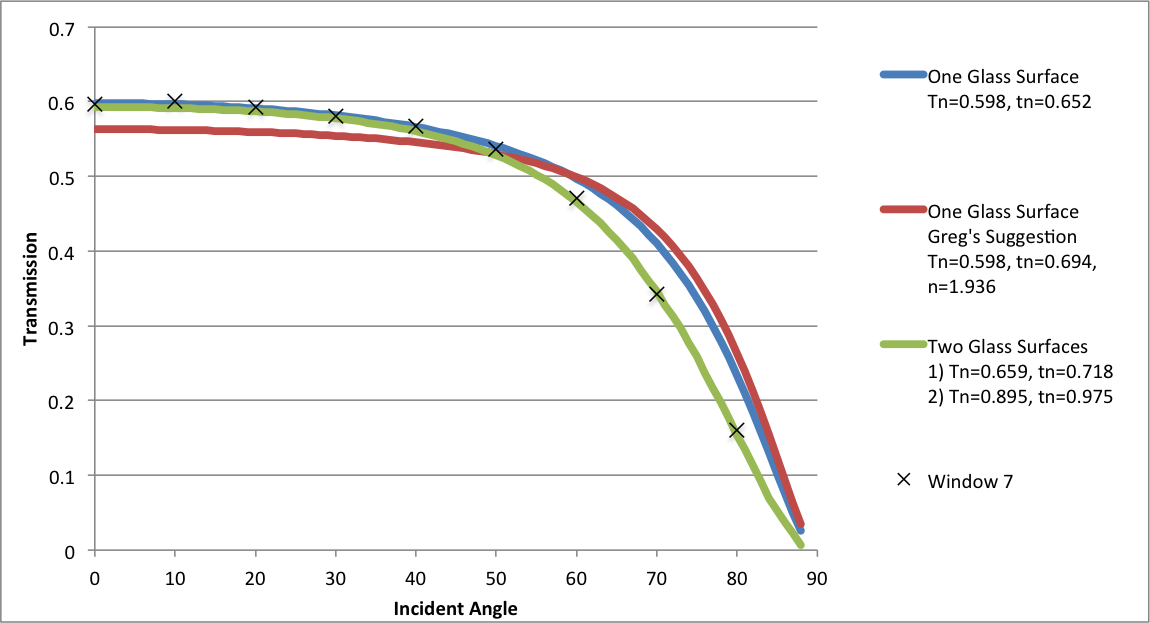First time here? Check out the Help page!
 | 1 | initial version |
Rob,
You shouldn't use a single glass surface in Radiance to represent a whole IGU, but many do (including myself at times).
The Radiance glass material is an optimization for thin sheets of glass. Fresnel equations are used to determine non-normal transmission. If you use the normal transmittance of an IGU with two glass panes your simulation will under predict the fall off in transmission at higher incident angles.
When you have an IGU with two sheets of glass the best option is to either use the glaze script to create a BRTDfunc for your IGU or to use two parallel glass materials. When I have enough points I will post a chart showing the total transmission at different incidence angles for one vs. two glass surfaces to represent an IGU. The chart shows the transmission of an IGU modeled with two glass surfaces (64% transmission and 90% transmission) and one glass surface (58% transmission). The simplification is fine up to 45% off normal, but above 45% the difference becomes more apparent.
Andy
 | 2 | No.2 Revision |
Rob,
You shouldn't use a single glass surface in Radiance to represent a whole IGU, but many do (including myself at times).
The Radiance glass material is an optimization for thin sheets of glass. Fresnel equations are used to determine non-normal transmission. If you use the normal transmittance of model an IGU with two using a single glass panes surface and the transmission of IGU your simulation will under predict the fall off in transmission at higher incident angles.
When you have an IGU with two sheets of glass the best option is to either use the glaze script to create a BRTDfunc for your IGU or to use two parallel glass materials. When I have enough points I will post a chart showing the total transmission at different incidence angles for one vs. two glass surfaces to represent an IGU. The chart shows the transmission of an IGU modeled with two glass surfaces (64% transmission and 90% transmission) and one glass surface (58% transmission). The simplification is fine up to 45% off normal, but above 45% the difference becomes more apparent.
Andy
 | 3 | No.3 Revision |
Rob,
You shouldn't use a single glass surface in Radiance to represent a whole IGU, but many do (including myself at times).
The Radiance glass material is an optimization for thin sheets of glass. Fresnel equations are used to determine non-normal transmission. If you model an IGU using a single glass surface and the transmission of IGU your simulation will under predict the fall off in transmission at higher incident angles.
When you have an IGU with two sheets of glass the best option is to either use the glaze script to create a BRTDfunc for your IGU or to use two parallel glass materials. When I have enough points I will post Below is a chart showing the total transmission at different incidence angles for one vs. two glass surfaces to represent an IGU. The chart shows the transmission of an IGU modeled with two glass surfaces (64% transmission and 90% transmission) and one glass surface (58% transmission). The simplification is fine up to 45% off normal, but above 45% the difference becomes more apparent.

Andy
 | 4 | No.4 Revision |
Rob,
You shouldn't use a single glass surface in Radiance to represent a whole IGU, but many do (including myself at times).
The Radiance glass material is an optimization for thin sheets of glass. Fresnel equations are used to determine non-normal transmission. If you model an IGU using a single glass surface and with the transmission of the whole IGU your simulation will under predict the fall off in transmission at higher incident angles.
When you have an IGU with two sheets of glass the best option is to either use the glaze script to create a BRTDfunc for your IGU or to use two parallel glass materials. Below is a chart showing the total transmission at different incidence angles for one vs. two glass surfaces to represent an IGU. The chart shows the transmission of an IGU modeled with two glass surfaces (64% transmission and 90% transmission) and one glass surface (58% transmission). The simplification is fine up to 45% off normal, but above 45% the difference becomes more apparent.

Andy
 | 5 | No.5 Revision |
Rob,
You shouldn't use a single glass surface in Radiance to represent a whole IGU, but many do (including myself at times).
The Radiance glass material is an optimization for thin sheets of glass. Fresnel equations are used to determine non-normal transmission. If you model an IGU using a single glass surface with the transmission of the whole IGU your simulation will under predict the fall off in transmission at higher incident angles.
When you have an IGU with two sheets of glass the best option is to either use the glaze script to create a BRTDfunc for your IGU or to use two parallel glass materials. Below is a chart showing the total transmission at different incidence angles for one vs. two glass surfaces to represent an IGU. The chart shows the transmission of an IGU modeled with two glass surfaces (64% transmission and 90% transmission) and one glass surface (58% transmission). The simplification is fine up to 45% off normal, but above 45% the difference becomes more apparent.

Andy
EDIT:
Rob, I just ran a new test including Greg's suggestion and angular transmission results from Window 7. I'm assuming that Window 7 is correct (see chart below). Greg's suggestion (red line) is further from what Window 7 gives (black Xs) than any of the other options I tested.
tn=0.598/(1-0.138)=0.6937

 | 6 | No.6 Revision |
Rob,
You shouldn't use a single glass surface in Radiance to represent a whole IGU, but many do (including myself at times).
The Radiance glass material is an optimization for thin sheets of glass. Fresnel equations are used to determine non-normal transmission. If you model an IGU using a single glass surface with the transmission of the whole IGU your simulation will under predict the fall off in transmission at higher incident angles.
When you have an IGU with two sheets of glass the best option is to either use the glaze script to create a BRTDfunc for your IGU or to use two parallel glass materials. Below is a chart showing the total transmission at different incidence angles for one vs. two glass surfaces to represent an IGU. The chart shows the transmission of an IGU modeled with two glass surfaces (64% transmission and 90% transmission) and one glass surface (58% transmission). The simplification is fine up to 45% off normal, but above 45% the difference becomes more apparent.

Andy
EDIT:
Rob, I just ran a new test (see chart below) including Greg's suggestion and angular transmission results from Window 7. I'm assuming that Window 7 is correct (see chart below). correct. Greg's suggestion (red line) is further from what Window 7 gives (black Xs) than any of the other options I tested.
here's how the transmissivity was calculated for Greg's suggestion: IGU Tn= 0.598 IGU Rn= 0.138 tn=0.598/(1-0.138)=0.6937

 | 7 | No.7 Revision |
Rob,
You shouldn't use a single glass surface in Radiance to represent a whole IGU, but many do (including myself at times).
The Radiance glass material is an optimization for thin sheets of glass. Fresnel equations are used to determine non-normal transmission. If you model an IGU using a single glass surface with the transmission of the whole IGU your simulation will under predict the fall off in transmission at higher incident angles.
When you have an IGU with two sheets of glass the best option is to either use the glaze script to create a BRTDfunc for your IGU or to use two parallel glass materials. Below is a chart showing the total transmission at different incidence angles for one vs. two glass surfaces to represent an IGU. The chart shows the transmission of an IGU modeled with two glass surfaces (64% transmission and 90% transmission) and one glass surface (58% transmission). The simplification is fine up to 45% off normal, but above 45% the difference becomes more apparent.

Andy
EDIT:
Rob, I just ran a new test (see chart below) including Greg's suggestion and angular transmission results from Window 7. I'm assuming that Window 7 is correct. Greg's suggestion (red line) is further from what Window 7 gives (black Xs) than any of the other options I tested.
here's how the transmissivity was calculated for Greg's suggestion:
suggestion:
IGU Tn= 0.598
0.598
IGU Rn= 0.138
0.138
tn=0.598/(1-0.138)=0.6937

 | 8 | No.8 Revision |
Rob,
You shouldn't use a single glass surface in Radiance to represent a whole IGU, but many do (including myself at times).
The Radiance glass material is an optimization for thin sheets of glass. Fresnel equations are used to determine non-normal transmission. If you model an IGU using a single glass surface with the transmission of the whole IGU your simulation will under predict the fall off in transmission at higher incident angles.
When you have an IGU with two sheets of glass the best option is to either use the glaze script to create a BRTDfunc for your IGU or to use two parallel glass materials. Below is a chart showing the total transmission at different incidence angles for one vs. two glass surfaces to represent an IGU. The chart shows the transmission of an IGU modeled with two glass surfaces (64% transmission and 90% transmission) and one glass surface (58% transmission). The simplification is fine up to 45% off normal, but above 45% the difference becomes more apparent.

Andy
EDIT:
Rob, I just ran a new test (see chart below) including Greg's suggestion and angular transmission results from Window 7. I'm assuming that Window 7 is correct. Greg's suggestion (red line) is further from what Window 7 gives (black Xs) than any of the other options I tested.
here's how the transmissivity was calculated for Greg's suggestion:
IGU Tn= 0.598
IGU Rn= 0.138
tn=0.598/(1-0.138)=0.6937


